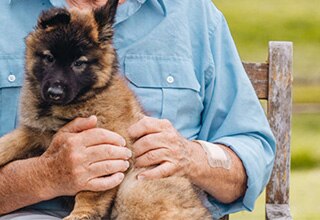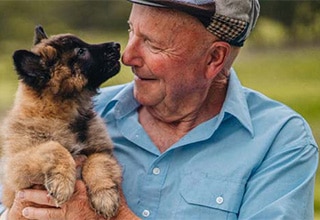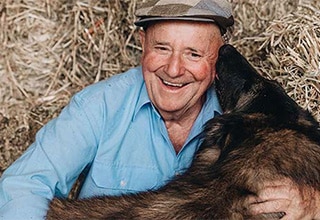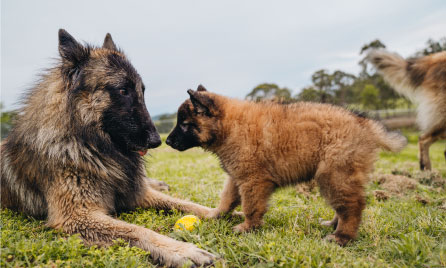- text
-
# Policy Terms and Conditions, exclusions and limits apply. Benefit limit amounts vary by level of cover.
Dr Harry: The first 200 days of owning a puppy.
Welcoming a new puppy into your life brings excitement, companionship, and a whole lot of love, but with this comes responsibility. The first 200 days of pet ownership are critical to helping your pup learn valuable skills and behaviours.
Choosing a puppy.
Perhaps you haven’t picked your particular pup and suddenly you are confronted with a litter of six gorgeous Labradors. How do you choose? They all look the same. The old trick is simply to call “puppy, puppy, puppy'' in a high pitched voice and see who responds first. Yeah, it’s not a bad idea, but here’s a better one. Take along a little plastic ball with a bell inside. It’s a cat toy. Roll it along the ground and watch for the puppies’ reaction.
There are usually three different responses. Those pups that chase after it are the real extroverts, full of life and ready to go, and often tear aways when young.
These dogs often train well. The next group simply follows the extroverts. They will be fine too, but less of a handful when they are young. The third group won’t react at all. Roll the little ball directly at a puppy who is behaving this way. If the pup remains still, you’ll likely have a quieter dog. If however, the puppy runs away, this may be a timid individual, and while well suited to certain owners, they are much harder to train. I often equate it to driving a vehicle in reverse from Sydney to Melbourne.
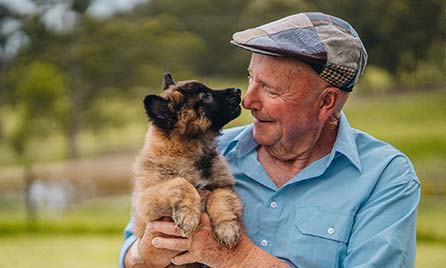
Taking your puppy home.
Well, at last, that wonderful day has arrived, and you are off to collect that puppy you’ve been longing to meet. Everyone is excited, and that’s natural, but please take a few precautions along the way to make sure the trip home goes well. In most states of Australia, it is illegal to have a dog unrestrained in a motor vehicle, including your puppy. Borrowing a plastic carry cage is the best idea.
If you have already picked out your particular puppy, then you can get on your way once the paperwork has been completed. There will be a couple of pages of instructions regarding diet, worming, vaccination, and possibly even training. Often the contact of the breeder’s vet is included too. The kids are jumping up and down and debating who will hold the puppy. I’ve already spelt the answer to that. No one, until you get home!
Getting home with your puppy.
Now you’re home. Everyone wants to cuddle the puppy. Fair enough, but I ask you, do dogs really like being cuddled? Have you seen them cuddle with one another? Not really. They certainly love contact with each other and with us, but the often well intended squeezing as a measure of our love makes some dogs very uncomfortable.
My number one rule is if young children are going to handle the puppy, then they must sit on the floor. You would be surprised by how many accidents we vets see as a result of a young owner dropping a squirming puppy. Show your love by stroking, and in time use a soft brush as well. Grooming greatly increases the bond between dog and owner. Sleeping quarters are the number one priority. Young pups will like to sleep in a ‘donut’, a round padded bed where they can nestle and feel ‘surrounded’. The first few nights can be a bit daunting. The pup is suddenly alone, in a strange environment without the usual smells and of course its litter mates.
Here are some tips on how to calm them down:
Use a ticking clock as a soothing background noise.
Play soft rumbling classical music.
Get a small heating pad to keep your puppy warm.
If you keep getting up to the pup every time it cries (and it will), you are simply rewarding the behaviour and it will get worse. A baby monitor allows you to see what is going on, and some allow you to actually talk to the puppy in a soothing voice, without having to be there.
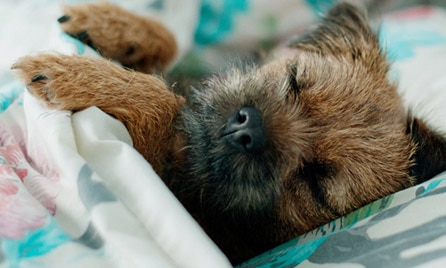
I was told quite young that one should start off in life the way you mean to finish. Guess what, the same rule applies to your new addition. You should make plans, as a family, for the way you’ll manage this ball of mischief. Please stick to them. Dogs like routine, and constantly changing the goal posts makes it hard for the dog to adapt. Food and water bowls should be in the same place, as should the bed. If that bed happens to be yours too, well it might pay to have some sort of cover over the duvet to protect from accidents.
Make any and all changes gradually, particularly when it comes to diet. Remember too that until the course of vaccinations is complete, your puppy will not be fully protected against all those infectious diseases. Your vet will be able to advise you about heartworm, intestinal worms, and tick and flea control which will vary according to where you live. Make a list of queries to ask your vet when it comes time for your pup’s next vaccination.
Toilet training your puppy.
Training is just so vital to having a great relationship with ‘man’s best friend’, and of course a ladies best friend as well. Toilet training requires patience. Females often learn faster than males. There are lots of things dogs don’t know and it’s up to you as the owner to teach them. Most pups will want to use their bladder or their bowels pretty soon after eating and they will be on three or four meals a day, so there’s plenty of time to practice. You know when things are going to ‘happen’ as your puppy will start sniffing around before it actually eliminates. You must act quickly. Gently, but speedily:
- Pick the pup up and cart it outside.
- Give some sort of command, like “TOILEEEEY” or “GO DO IT” in a gentle but commanding voice, and be patient.
- When you get a result, get really excited and praise your little bundle for doing the right thing.
- Praise and a pat are all you need.
If you’re in a high rise and going into the backyard, that means a 30 floor descent in the elevator. Using a mat on which your fur baby can ‘go’ will be more practical in this situation. You can make these yourself from squares of artificial grass, and keep them on the balcony or in the bathroom. They are easily washed, and even look and feel like grass.
Sometimes you have to be a little devious and actually ‘seed’ the mat with a few drops of urine from another dog. Dogs love to play cards, they trump each other and your pup will be drawn to the smell and feel it is the place to ‘go’. You need a lot of patience and there is no point in punishing mistakes, it doesn’t register with your pup, rather ignore them and reward the successes.
Training and rewarding your puppy.
This brings me to my real Hobby Horse, and the reason I’ve titled this monologue the first 200 days. It’s all about training, and the principles are just so simple. It’s called positive reinforcement training. Put simply, a dog is highly likely to repeat a certain action if it receives a reward for doing it. In Australia, most trainers use food as a reward. Often overseas a toy can act as the same reward, and simple toys like a rolled up towel or a ball are the techniques used by so many of our military, customs and border protection dogs. It’s what works best for your dog.
You start that training the day your pup arrives home. It’s about consistency, patience and perseverance. A lot of this you can practice like sit, stay and drop.
The techniques are simple, and at puppy preschool, you will pick up the techniques if you haven’t already. Most preschools will take your best friend from 12 weeks of age. Please ensure the puppy trainer has themselves been trained, and possesses some certification and experience. This is THE most important start to your puppy’s life journey. It is in the first 200 days that your companion will form just about all the attitudes and traits that it will carry through the rest of its life.
Teaching obedience to your puppy.
Previously, I talked about 75% of a dog’s behaviour being inherited from the parents. In those first 200 days, you have the opportunity to mould things. If you are a good trainer you will often correct problems early in the life of your dog. If you do nothing, the status quo will remain or get worse. If you have difficulty with training, you will exaggerate any unwanted behaviours and ‘fix’ them in your dog.
Your next step is an obedience club, where qualified instructors will help guide you and your dog through the very basics of training. They are great organisations, where the whole family can become involved, and so they should, after all, that thing with the waggly tail is part of the family isn’t it? I’m sure your children go to school, so should your dog!
Instructors will advise on things like leads, collars and harnesses. They teach walking techniques and handy tools like crate training. As your pup grows into a mature dog, you may be interested to go further into the fields of agility, fly-ball and tracking. The fun you can have with your dog is endless, and the social interactions of like-minded people can make for lifelong friendships.
There is so much more to say on refining training techniques we could go on and on. Etiqueh, my Belgian Shepherd’s greatest motivation is a ball. It’s her training reward. She came from Sweden at the age of four and travelled out with a much younger dog as company. She was originally owned by a young couple who lived in a small apartment. Life for her was not good. She spent from 6am to 6pm alone in that place. Bored beyond belief, she started to bark. She is still a ‘barker’. She will always be anxious. Will I ever eliminate the problem? I doubt that I will, but control it I do, simply with a hand signal like a policeman on point duty, and my eyes. I only wish she had been mine for those first 200 days, how much more at ease would she be with life.
Why pick Everyday Pet Insurance?
Related articles.
- text
-
= The gap is defined as the difference between the vet's invoice and the claim benefit under your policy. Policy terms and conditions apply. GapOnly® is only available at participating Vets. Please visit GapOnly® to search for GapOnly® enabled vets. GapOnly® is a trademark owned by PetSure (Australia) Pty Ltd (PetSure) (ABN 95 075 949 923, AFSL 420183).
- text
-
‡ Cover is available for the life of your pet provided you renew your policy each year without any break, lapse or change in the level of Cover. This means once your pet is insured with us and as long as we continue to offer the product, you will be able to renew your policy for that pet for life and your cover level will not be reduced as your pet ages provided you continuously maintain the cover. Cover is subject to the terms and conditions of your renewing policy. See details in your PDS.
- text
-
* Limits, waiting periods, exclusions and excesses may apply.
- text
-
† Offer available to new Everyday Pet Insurance policyholders, and is limited to 1 membership per eligible policy. The free membership offer (valued at $199p.a) is from the date of your policy commencement, provided your Everyday Pet Insurance policy remains active. You are not eligible to redeem the free membership subscription for cash or credit. VetAssist is a separate subscription based service to the Everyday Pet Insurance product, and is provided independently by Everyday Insurance third party service provider, VetChat Services Pty Ltd (VetChat). Click here for full VetAssist Service terms and conditions. Everyday Insurance reserves the right to vary or remove this offer at any time and will provide reasonable notice of any such changes.
- text
-
Dr Harry Cooper (AR No.1000933) is an Authorised Representative of PetSure (Australia) Pty Ltd (AFSL 420183). Any advice provided by Dr Harry Cooper in relation to Everyday Pet Insurance is general only and does not take into account your individual objectives, financial situation or needs.
- text
-
Everyday Pet Insurance policies entered into for the first time prior to 17 July 2023 and subsequent renewals of those policies are issued by The Hollard Insurance Company Pty Ltd ABN 78 090 584 473, AFSL 241436 (Hollard), arranged and administered by PetSure (Australia) Pty Ltd ABN 95 075 949 923, AFSL 420183 (PetSure) and promoted and distributed by Hollard’s Authorised Representative (AR) Woolworths Group Limited ABN 88 000 014 675, AR 245476 (Woolworths). Everyday Pet Insurance policies entered into for the first time on or after 17 July 2023 and subsequent renewals of those policies are issued by PetSure and promoted and distributed by PetSure’s AR, Woolworths. Any advice provided is general only and does not take into account your individual objectives, financial situation or needs. Please consider the Product Disclosure Statement (PDS) to ensure this product meets your needs before purchasing, or choosing to continue with the product. PDS and Target Market Determination available at insurance.everyday.com.au/pet-insurance.
